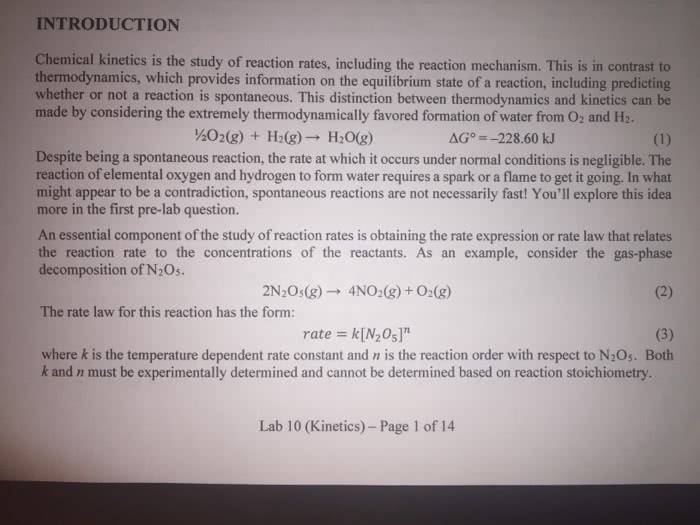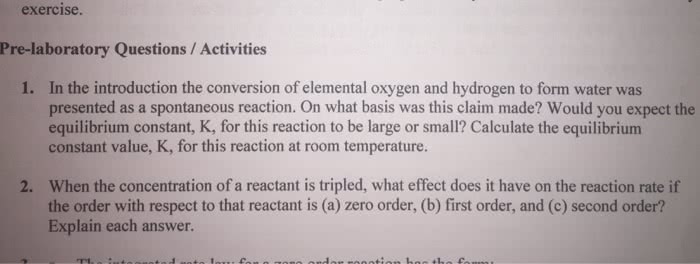CHEM 1001 Lecture Notes - Lecture 14: Jmol, Activated Complex, Bromine

CHAPTER 14: Chemical Kinetics
Kinetics vs Thermodynamics
Thermodynamics: tells us which direction a reaction will go (e.g. at room temperature
and standard pressure, carbon is stable as graphite)
Kinetics: can tell us how quickly reaction will get there/proceed (e.g. a diamond will not
convert to graphite during your lifetime)
14.1 Speed of Chemical Reactions
The reaction of sugar with oxygen is very favourable: usually slow at room temperature;
enzymes can control the rate of reaction. Reaction of gasoline with oxygen is very
favourable too: usually slow at room temperature but a spark can make the reaction occur
very rapidly.
Rates of Chemical Reactions: expressed as the rate of change of concentrations.
Concentrations could be reactants or products; properly expressed as derivatives; may be
approximated in terms of differences.
Example: Sn2+ + 2Fe3+ → Sn4+ + 2Fe2+. Rate ≈ Δ[Sn4+ ]/Δt change in concentration
of Sn4+/ change in time. Units are usually: M/s = mol/L.s. Dimensions are always
'amount' / 'time’.
Rate is a slope: easy IF a plot of concentration vs. time gives a straight line. However, rate
is usually not constant, so graph is usually not straight line. So the rate will become
derivative of concentration/time at any point (derivative gives slope of tangent line at a
point of the graph).
Stoichiometry is Important: Rates can be different for different species. Example: Sn2+ +
2Fe3+ → Sn4+ + 2Fe2+. Rate of formation of Fe2+ is twice as fast as rate of formation of
Sn4+ because 2 mol Fe2+ per 1 mol Sn4+.
Definition of Reaction Rate: defined in terms of rate of change of concentration. Reaction rate
can be written as equal to the rate of producing a product/reactant with a stoichiometric coefficient
of unity. Chemical equation must be properly balanced. According to past equation, reaction rate
is equal to Δ[Sn4+ ]/ Δt but ½ Δ[Fe2+ ] /Δt. But depends on how reaction is written, can be
different. NOTE: Rate of consumption = +ve but rate of change = -ve for reactants
General Reaction: aA + bB → gG + hH
The rates of loss of A and B & production of G and H can be expressed through the rates
of change in their concentrations (if volume is constant):
d[A]/ dt , d[B]/ dt , d[C] /dt , d[D] /dt is equal to Δconcentration/Δtime
Reaction rates are always positive. Rates of change of products are positive; reactants are
negative. Divide by the stoichiometric coefficient. Units are usually M/s = mol/ L.s =
amount/time. Inverse, sort of… you have to multiply rate of consumption by whatever # will
make its coefficient equal 1. For reactants, -1 / coefficient; products is +1/coefficient. All
multiplied by their rate of consumption/production (Δconcentration/Δtime or
d[product/reactant]/dt) to find out the rate of the overall reaction.
Example question: 2A + B C + D. [A] = 0.3629M, and after 8.25 min [A] = 0.3187M.
Rate of consumption of A = change in [A] / change in time = 0.3187 – 0.3629 / 8.25 = 0.00536 M/min
Average rate of reaction = ½ times rate of consumption of A = 0.00268 M/min
14.2 Measuring Reaction Rates
Reaction rate changes as the reaction proceeds it depends on:
find more resources at oneclass.com
find more resources at oneclass.com

Concentrations of: reactants, products, & other species (catalysts)
Temperature, solvent, phase, pressure
Other reactions
There are ways to describe these dependencies – rate laws.
Measuring reaction rates concept is simple:
(1) Mix reactants together. (2) Measure concentration at a particular time. Method depends on the
species in the reaction. (3) Repeat step 2 over and over. (4) Make graph or table of concentration
vs. time. (5) Determine the slope (several options)
Example (Experiment): H2O2(aq) → H2O(l) + 1/2 O2(g)
-Could follow this reaction by measuring volume of O2(g) produced or H2O2(aq) consumed at different
times. Measuring H2O2 produced is easier: (1) Withdraw aliquot from reaction solution. (2) Add
aliquot to permanganate solution: 2MnO4- + 5 H2O2 + 6 H+ → 2Mn2+ + 8H2O + O2(g) (3) Measure
loss of H+ (change of pH) electrochemically. (4) Repeat steps (1) to (3) at intervals (every 400
seconds). This will create a table of values for reaction rate as an average over 400s intervals.
Average and Instantaneous Rates
The average rate, Δ[H2O2]/Δt, is determined by slope between 2 points, like in previous table
The instantaneous rate, d[H2O2]/dt, is determined by slope of tangent at 1 point. It is the correct
value; to obtain it: approximate by Δ[H2O2]/Δt (fine if Δ[H2O2] is small should be as small as
possible). Graph the data in a way that gives a straight line. Use integrated rate laws and calculus.
14.3 The Rate Law/Equation: relationship between reaction rate and concentrations of reagents
(depend on each other) simple for elementary reactions. 2 types of rate laws:
1. Differential: reaction rate as function of concentration
2. Integrated: concentration as function of time
Unimolecular Reactions: elementary reactions of a single molecule (1 reactant; 1 step)
N2O3 → NO + NO2 (dissociation) or HCN → CNH (isomerization)
Reactions require breaking chemical bonds (and perhaps forming new ones), so an input of energy is
normally needed: collisions with other molecules and absorbing radiation (light).
Rate Law for Unimolecular Reactions: rate of reaction is directly proportional to the concentration of
the reacting molecule. Reaction must be written so the reacting molecule has a stoichiometric
coefficient of unity (coefficient 1). E.g.:
Correct: N2O4 → 2NO2 but Incorrect: ½N2O4 → NO2
Rate law: reaction rate = -d[N2O4]/dt = k[N2O4] where k is proportionaly factor called rate constant or
rate coefficient. Example of first-order reaction. Reaction rate has units of concentration/time. The rate
constant, k, has units of time-1 value is different for each reaction and may depend on temperature,
solvent, phase, and pressure.
Half-Life: time it takes for one half of a reactant to be converted into product
Implications of the rate law for unimolecular reactions: in any interval of time, a molecule has a certain
probability of reacting; the fraction of remaining molecules that react is the same; the time that it takes
for half the remaining molecules to react is constant. Later we’ll see how half-life is related to k.
Bimolecular Reactions: elementary reactions between two molecules (2 reactants; 1 step)
Reaction must be written so that all stoichiometric coefficients are integers. NO + O3 → NO2 + O2
Rate Law for Bimolecular Reactions
find more resources at oneclass.com
find more resources at oneclass.com

The rate of reaction is directly proportional to the concentrations of each of the reacting molecules.
NO + O3 → NO2 + O2 Rate law: reaction rate = d[NO2]/dt = k[NO][O3]
2HO2 → H2O2 + O2 Rate law: reaction rate = d[H2O2]/dt = k[HO2]2
k is the rate constant or rate coefficient.
Units of concentration are usually M, but not always. Units of time are seconds, or minutes, or hours,
etc. The reaction rate has units of concentration time-1. The rate constant has units of concentration-1
time-1. k is different for each reaction and may depend on temperature, solvent, phase, and pressure.
This is an example of a: second order reaction.
Rate Laws for Multi-Step Reactions
Rate laws for elementary reactions: very simple, depend only on concentrations of the reactants,
& can be determined from the equation for the reaction.
Reactions that require more than one step are not so simple. But there are similarities: reaction
rates still depend on the concentrations of the reagents (but not just the reactants). The rate law gives
the relationship between the reaction rate and concentrations.
Properties of Rate Laws
Typically (but not always), the rate law is of the form: rate of reaction = k[A]m[B]n
[A] and [B] represent reagent molarities. k, m, and n are constants for any particular reaction. There
may be more or fewer than two reagents in the rate law. The reagents are usually, but not always,
reactants or products. m and n are often small, positive integers. But they may be zero, fractional, and/or
negative.
The Constants m, n and k : rate of reaction = k[A]m[B]n
Reaction order: order m for A, n for B, etc. Overall reaction order is m+n.
Rate constant (k): a proportionality constant. The faster the reaction, the larger the value of k. k
depends on temperature, pressure, solvent, & phase. The units for k depend on reaction order.
Concentration unit is usually M; time unit
is seconds, minutes, or hours. Rate always
has units concentration/time, and doing k
= rate/concentrations of each reagent
gives units for k in this table.
Examples of Reaction Order
reaction rate = k[N2O4] First order in N2O4 & first order overall
reaction rate = k[NO][O3] 1st order in NO, 1st in O3, 2nd overall though.
Reaction Order and Molecularity: terms unimolecular (a single molecule dissociates or isomerizes)
and bimolecular (two molecules collide and react) apply only to elementary reactions, while reaction
order applies to all reactions. All unimolecular reactions are 1st order, & all bimolecular are 2nd order,
although being 1st/2nd order doesn’t guarantee being unimolecular/bimolecular.
Establishing the Rate Law: determining k, m, n by analyzing experimental data.
2 methods: method of initial rates and method of integrated rate laws.
1) Method of Initial Rates (rate of reaction = k[HgCl2]m[C2O42-]n)
find more resources at oneclass.com
find more resources at oneclass.com
Document Summary
Thermodynamics: tells us which direction a reaction will go (e. g. at room temperature and standard pressure, carbon is stable as graphite) Kinetics: can tell us how quickly reaction will get there/proceed (e. g. a diamond will not convert to graphite during your lifetime) The reaction of sugar with oxygen is very favourable: usually slow at room temperature; enzymes can control the rate of reaction. Reaction of gasoline with oxygen is very favourable too: usually slow at room temperature but a spark can make the reaction occur very rapidly. Rates of chemical reactions: expressed as the rate of change of concentrations. Concentrations could be reactants or products; properly expressed as derivatives; may be approximated in terms of differences. Example: sn2+ + 2fe3+ sn4+ + 2fe2+. Rate [sn4+ ]/ t change in concentration of sn4+/ change in time. Rate is a slope: easy if a plot of concentration vs. time gives a straight line.



